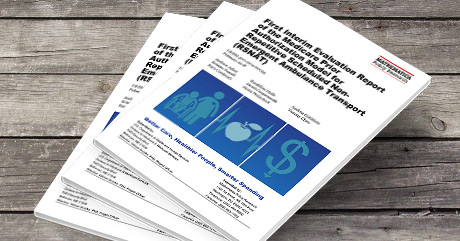Medicare Prior Authorization- Results 3 Years Later
History
In December 2014, the Centers for Medicare and Medicaid Services (CMS) implemented a Medicare Prior Authorization program on a three-year trial for RSNAT- repetitive, Scheduled, non-emergency ambulance transports. The program targeted three States that statistically showed a sharp increase in these types of transports at an alarming rate when compared with other states (ambulance usage approximately 50 percent higher.) The States included New Jersey, Pennsylvania and South Carolina.

CLICK HERE TO VIEW THE REPORT
Later in January 2016, Phase II of the trial driven by the Medicare Access and CHIP Reauthorization Act of 2015 (MACRA) expanded the RSNAT prior authorization model to six additional states. Phase II states included Delaware, the District of Columbia, Maryland, North Carolina, Virginia and West Virginia.
As required under the program, CMS engaged Mathematica Policy Research, a nonpartisan think tank, to conduct a five-year evaluation to study the impact of the prior authorization model. Mathematica used guiding research questions across five “domain” areas- Cost Savings, Quality and Access, Program Operations, Suppliers and Providers and Improper Payment Rates. The report also capsulizes the implications of the findings and highlights the major lessons learned from the project.
Interestingly, but not surprising, the report wound up focusing heavily on End Stage Renal Disease (ESRD) patients who accounted for more than 75% of the repetitive transports reviewed. The transports of ESRD patients has long been the focus for CMS which has continually been questioning the medical necessity and reasonableness in justifying payments for those patient transports. The Feds even moved to combat the growth in ESRD slicing payments for those transports below the normal Medicare National Ambulance Fee Schedule allowances, twice, with the most recent cuts coming just this year.
The research project ended one month ago when Mathematica released its report titled First Interim Evaluation Reports of the Medicare Prior Authorization Model for Repetitive Scheduled Non-Emergent Ambulance Transport (RSNAT). The extensive report amasses just shy of 100 pages of findings and data to support those findings.
Cost Savings
Mathematica reports that the prior authorization program reduced Medicare payments for RSNAT service expenditures for ESRD beneficiaries by $171 million across the nine participating states. That is a decrease of at least 80 percent in service utilization and costs in those model states for ESRD beneficiaries.
The report cites that stakeholders in the program perceive that the prior authorization model is achieving success in addressing the fraud and abuse connected with these types of transports. The results appear to be significant enough that we can only deduce that the program will soon be expanded to include the entire United States, although no concrete plans have yet been announced for implementation. The reason for this delay was for the review of the impact report. Now that this report has been released, it would seem logical that CMS will recommend to Congress that the program be expanded to save resources and protect against improper payments.
Quality and Access
The report cites “little or no” impact on quality and/or adverse outcomes for ESRD beneficiaries backed up by studies of emergency department visit reviews, emergency ambulance utilization reviews as well as an analysis of unplanned inpatient admissions and even death. However, Mathematica’s research did find that there was a 15 percent spike in emergency dialysis use, suggesting a delay in ESRD treatment minus a transportation option for some of these patients.
Mathematica did find that there were some beneficiaries who qualify as medically necessary patients who experienced delays and/or missed treatments because of the time required for the ambulance to receive the prior authorization from the Medicare Administrative Contractors (MACs). Additionally, non-medically-necessary patients had trouble finding a transportation option to and from dialysis treatments because of the overall affect the program had on ambulance agencies in the nine program states.
Program Operations
It’s not a shock that the MACs reported successful implementation of the program overall. Why wouldn’t they say that? They are protecting their own skin in the game here (this blogger’s opinion, of course.)
Phase I or what the report calls “Year 1” states had a more difficult roll-out than “Year 2” affected MACs as the first phase MACs were creating a new program from scratch which is a logical explanation.
Suppliers and Providers
Big effect here!
The report documents a 15 percent decrease in the number of ambulance suppliers per 100,000 beneficiaries in the model states following the Prior Authorization Model implementation. It was noted that the suppliers that left the program were generally smaller companies that relied heavily on RSNAT transports for the bulk of their Medicare and overall operating revenue.
There were complaints recorded by stakeholders, most notably physicians, who claimed they received little or no advance notice or educational material regarding the prior authorization program implementation. These stakeholders indicated that the medical necessity determinations used to issue or deny the prior authorization were too strict and the medical necessity guidelines were not clear to the stakeholders, again primarily physicians, prior to the beginning of the trial program.
It appears that CMS and the MACs must still improve on their educational initiatives at all levels, not just for the ambulance industry participants.
Improper Payments Rates
Mathematica noted “data challenges” that made it difficult to properly assess whether the Prior Authorization model had an impact on improper payments. In fact, rates of improperly paid claims for all Medicare ambulance services actually increased during the analysis period.
However, it was noted that upon program model implementation the MACs issued denials more aggressively noting increased vigilance on the part of the MACs given their recognition of the program rollout.
Coming Next Week…
We’ll look at the report’s conclusions and possible implications next week in this space. We hope you’ll check back in again!